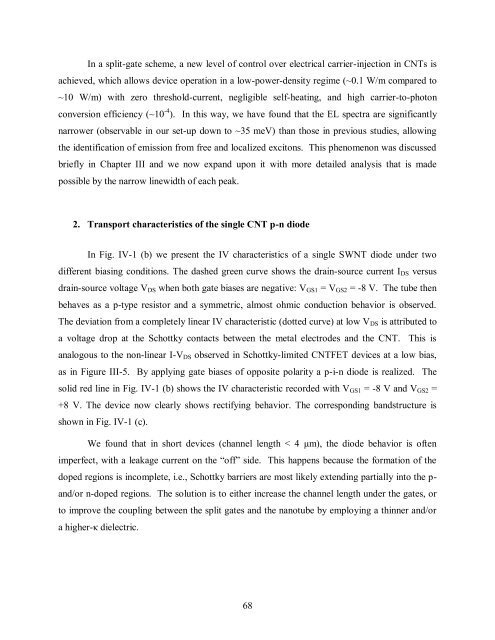Optoelectronics with Carbon Nanotubes
Optoelectronics with Carbon Nanotubes
Optoelectronics with Carbon Nanotubes
You also want an ePaper? Increase the reach of your titles
YUMPU automatically turns print PDFs into web optimized ePapers that Google loves.
In a split-gate scheme, a new level of control over electrical carrier-injection in CNTs is<br />
achieved, which allows device operation in a low-power-density regime (~0.1 W/m compared to<br />
~10 W/m) <strong>with</strong> zero threshold-current, negligible self-heating, and high carrier-to-photon<br />
conversion efficiency (~10 -4 ). In this way, we have found that the EL spectra are significantly<br />
narrower (observable in our set-up down to ~35 meV) than those in previous studies, allowing<br />
the identification of emission from free and localized excitons. This phenomenon was discussed<br />
briefly in Chapter III and we now expand upon it <strong>with</strong> more detailed analysis that is made<br />
possible by the narrow linewidth of each peak.<br />
2. Transport characteristics of the single CNT p-n diode<br />
In Fig. IV-1 (b) we present the IV characteristics of a single SWNT diode under two<br />
different biasing conditions. The dashed green curve shows the drain-source current IDS versus<br />
drain-source voltage VDS when both gate biases are negative: VGS1 = VGS2 = -8 V. The tube then<br />
behaves as a p-type resistor and a symmetric, almost ohmic conduction behavior is observed.<br />
The deviation from a completely linear IV characteristic (dotted curve) at low VDS is attributed to<br />
a voltage drop at the Schottky contacts between the metal electrodes and the CNT. This is<br />
analogous to the non-linear I-VDS observed in Schottky-limited CNTFET devices at a low bias,<br />
as in Figure III-5. By applying gate biases of opposite polarity a p-i-n diode is realized. The<br />
solid red line in Fig. IV-1 (b) shows the IV characteristic recorded <strong>with</strong> VGS1 = -8 V and VGS2 =<br />
+8 V. The device now clearly shows rectifying behavior. The corresponding bandstructure is<br />
shown in Fig. IV-1 (c).<br />
We found that in short devices (channel length < 4 μm), the diode behavior is often<br />
imperfect, <strong>with</strong> a leakage current on the “off” side. This happens because the formation of the<br />
doped regions is incomplete, i.e., Schottky barriers are most likely extending partially into the p-<br />
and/or n-doped regions. The solution is to either increase the channel length under the gates, or<br />
to improve the coupling between the split gates and the nanotube by employing a thinner and/or<br />
a higher-κ dielectric.<br />
68
















